May/June 2013
Rocky Roads and other fun flavors
The Caucasus: Georgia & Armenia
For this story only, you can call us by our new nicknames, Ben & Jerry, ‘cause we’re gonna tell you all about our new ice cream flavors: Monastery Mambo, Road Kill Surprise, Bent Border Berry, Wildflower Sorbet, Pedestrian Praline, Drivers R Bananas, and a new take on everyone’s old favorite -- Rocky Roads.
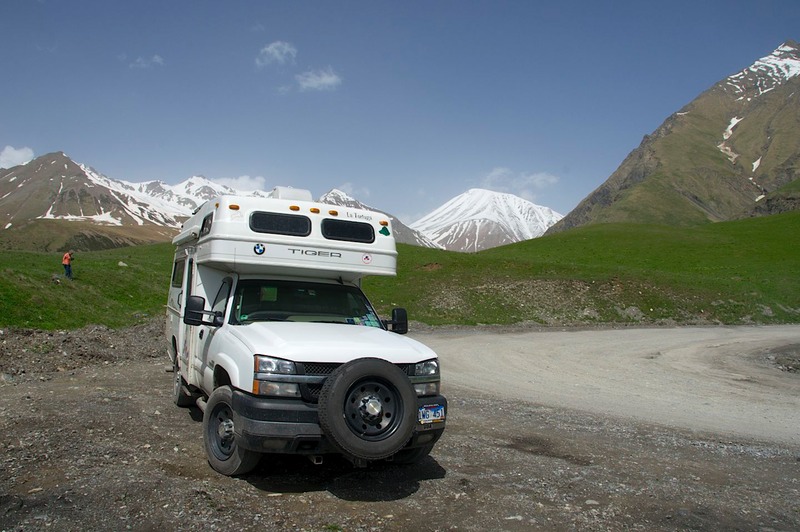
So, here we go. We were already in far eastern Turkey; so why not go see the Caucasus region – it’s right next door. Turkey has borders with Georgia, Azerbaijan, and Armenia – along with Iran, Iraq and Syria (as well as Greece and Bulgaria in the west, of course). We’d been traveling through parts of Turkey that used to be in Armenia and Georgia, and thought it might be neat to see those countries, too.
Our thoughts were fueled by another American couple traveling in the same area, Joyce and Ted Eve, who were in Georgia already. “Come on along,” they said. “There are complications, of course, but the countryside is beautiful, the people are friendly, the cherries are ripe, and all is well.” Hmm, well okay. So we arranged to have a guidebook to the area sent, along with a map, to an insurance office in Batumi, just across the border. We would be going there to get coverage for the areas we would be traveling in, so it was a natural. (Our European Green Card insurance would not cover us in the Caucasus.)
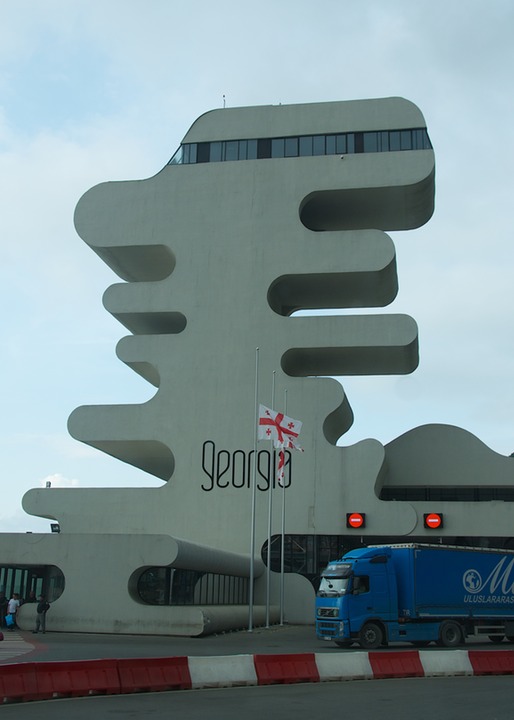
People come to the Caucasus region to see the countryside, enjoy the clear air, and to visit the ancient monasteries and churches. We enjoyed all of these things very much, and although the driving was strenuous and some other hurdles had to be negotiated, we are glad we made the effort. We visited Georgia and Armenia, but decided to skip Azerbaijan (even if we had finally learned how to spell it). It sounded less interesting to us, and long distances in hot weather would have been involved. In addition, the folks we were following had had border difficulties that we found off-putting.
Crossing into Georgia was pretty straightforward; there were plenty of cheerful officials speaking good English (and the guys were wearing these really dorky hats), and getting a 3-month permit for the truck wasn’t a problem. (Our visas, by the way, were good for a whole year.) We set our clocks ahead an hour and pressed on.
Batumi is just a few miles across the border, right along the Black Sea. We spent our first night in a large parking area with other motorhomes and visited Natia Moistsrapishvili at the offices of GPI Holding. She was expecting us, and within an hour she had our new insurance all set up. Natia got us all taken care of in good order and we were set to go. Then we retreated back down the coast a few miles, where we found lots of open land beside the Black Sea. After spending a few days writing our eastern Turkey message, reading the guidebook to figure out where we wanted to go, and getting our act together, we took off.
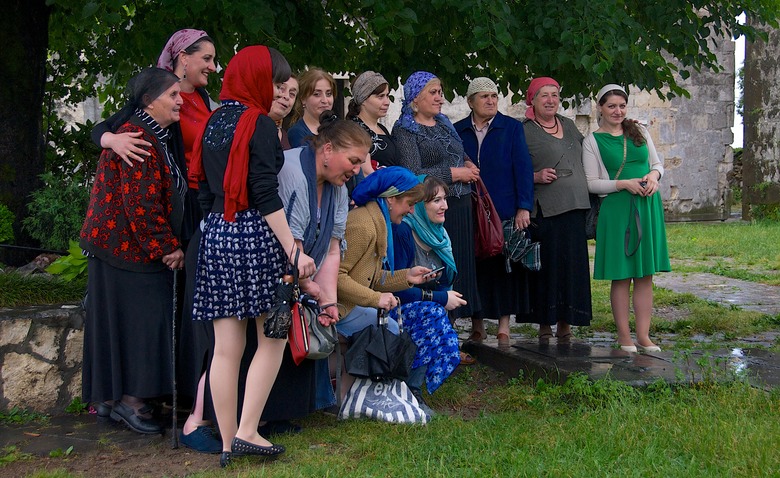
Already we had noticed that the people looked different, very Slavic (or Caucasian!).They were more heavy-set than the Turks, very light-skinned, and with different facial features. This was a real change.Also, amazingly, the young and middle-aged women mostly wore skirts and nylons. Not quite all of them, though. We stopped in at the local police station at one point, and it was completely staffed by women. They were in uniform pants and shirts --- and high-heeled sandals. Go figure! (The old ladies in town are all in black, of course; this is true everywhere in eastern Europe.) And, we were no longer in a Muslim country so clothing conventions, particularly for the women, were much different.
The cars we were seeing were different as well; lots of fancy Mercedes and Audis and BMWs. Georgia is not a wealthy country, and is economically depressed, but some folks sure are doing well (the “black leather jacket” folks). There is plenty of new construction going on in Batumi, a popular resort city, some of it quite whimsical; but there are also many old Soviet-era, ugly apartment buildings. This would be true throughout Georgia, and Armenia as well.
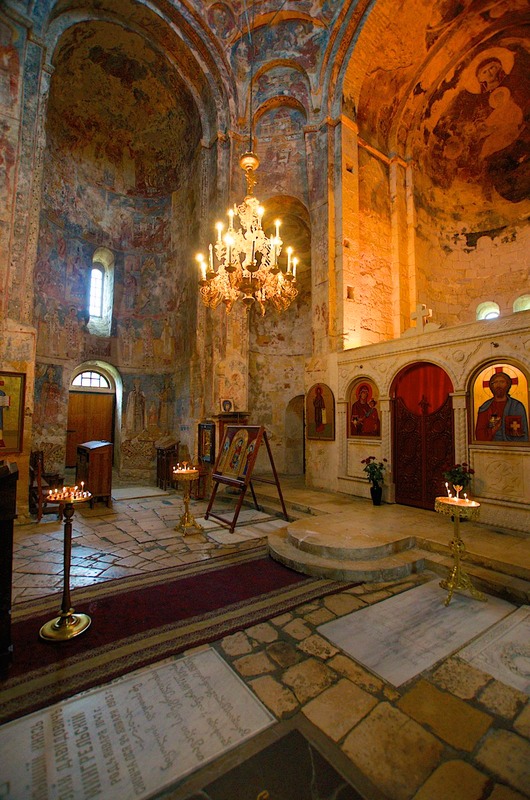
Food was cheaper in Georgia than it had been in Turkey. And, we were now able to buy things we couldn’t get there – pork being the most important! Bacon; sausages; ham; too cool. We stocked up. Even better, fuel was running about half the price we had been paying in Turkey. We were delighted. Our favorite fuel stations, Socar and Wissol, are everywhere. (Isn’t Wissol a great name? We pronounced it like weasel.) We had a great adventure at one of them. We’d been looking for a sticker that says “Georgia” on it; no luck anywhere. But the guys had one (once they figured out we were asking for an “emblem”) we could have; it also said Socar on it and the manager himself climbed up to the top of the truck and put it where Rick asked for it to be placed. They were all quite pleased with themselves.
Loaded to the gunnels with food, we headed out of town. Georgia is not a really large country, and there are two disputed areas you cannot visit (along parts of its border with Russia), so you have to take a convoluted route. We left the coast through a vast delta lowland area, with horses, geese, cows and pigs running loose all over the road (a constant throughout the country). It was warm, overcast and windy. This area drains to the Black Sea, and there was water everywhere. We saw lots of houses raised off the ground. And, once, we even saw what we’ll swear were water buffalo, although it was dusk and we weren’t quite sure. Could it be?
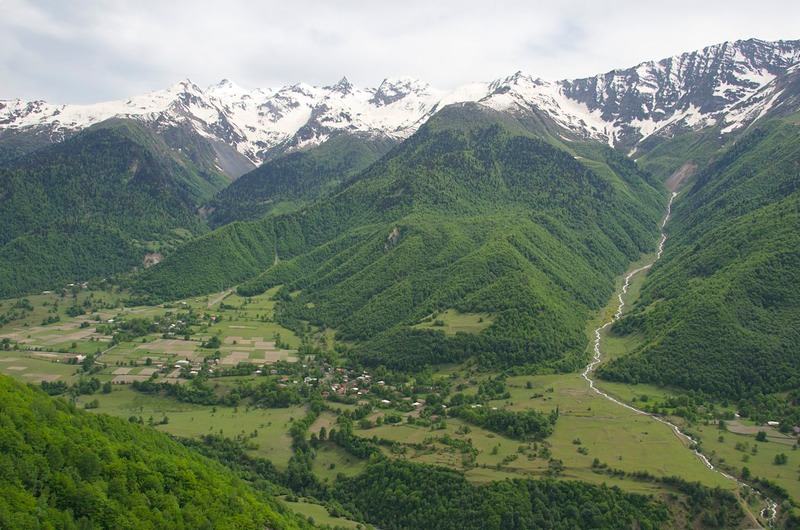
First order of business for us was to head northwest to the Svaneti region, high in the Caucasus Mountains. It is wild and beautiful, an ancient land hardly really connected to the rest of Georgia. The area is known for its medieval stone defense towers, called koshkis, where the villagers would retreat when being attacked. (We figured the attackers would simply starve them out, but what do we know.) They are picturesque and dramatic; you look out over a valley and see maybe 30 of them all sticking up out of the various hamlets. We stopped overnight in the ancient Becho Valley, where we startled quite a few folks who had probably never seen a motorhome before, and we made the Army guys really curious; they wanted to know what we were up to, this close to the Russian border. But we had a quiet night among the misty mountains and snowy peaks, next to a roaring stream and lots of yellow wildflowers.
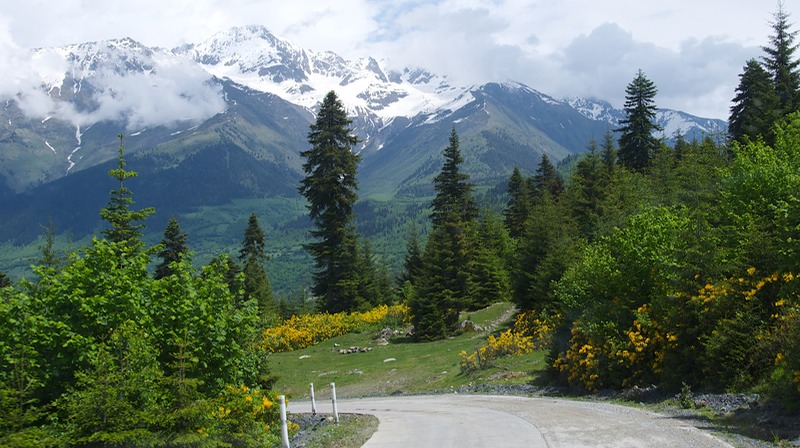
Mestia is probably the best known town in this area, and it’s being developed for tourism, with hotels and hiking trails and all the good stuff; even a ski station. We wanted to go on further, through Ushguli and on around on a loop that would take us south down into central Georgia. This would have been an efficient route, but the road was quite bad and the tourist office said we’d not be able to make it over the pass (6300 feet) because of snow – late in May. Phooey. So we had to retrace our steps, circling south and then east to get to Kutaisi, Georgia’s second city.
We spent one more night in the mountains, in a wide pull-off near the road. All was quiet until late evening, when we heard horses coming by. It was a couple of fellows riding along, and they pulled up to chat. They only had a few words of English, and asked us if we spoke Russian. Sadly, we don’t. Several times while traveling in the Caucasus region we would have been well served by knowing a bit of Russian, more so than any other language. Incidentally, Georgia has a unique alphabet, one of only 8 distinct alphabets in the entire world. Also, there are about 40 different languages spoken in the Caucasus region, most of them mutually undecipherable by others. A very complicated place as its history shows!
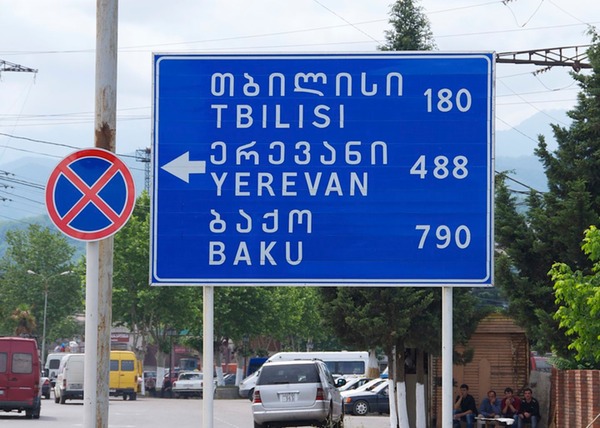
Kutaisi was difficult. We had intended to see the city, which is quite up-and-coming now that the Parliament has been moved here from Tbilisi, the capital. But we ran into real difficulties – ones that have been universal in these far-off-the-beaten- track countries. First, our GPS is almost useless (Emily thinks we’ve fallen off the edge of the map and drowned), and we tend to rely on her heavily in cities to get us through the mess as well as in locating the sites we want to visit. Second problem was the lack of either street signage or directional signs. We were totally lost all the time. We actually did get near Kutaisi’s tourist office at one point, but never were able to get back to it again. We finally found the McDonald’s, got on line, and Googled a map that showed us how to get out of town. We beat feet.
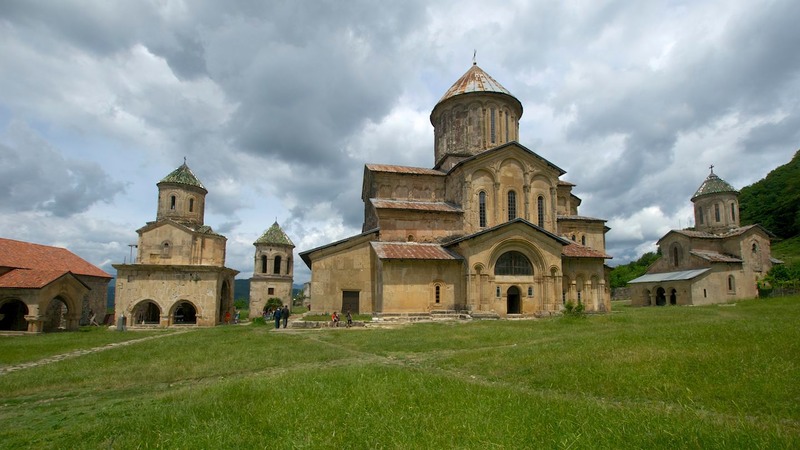
This probably all sounds rather minor, and what’s the big deal, but when you are always the new kids in town and have no idea where anything is -- with no decent map, no good signage and no GPS coverage -- it is very easy to wander around without ever finding whatever it is you are looking for. And added to the above are two larger issues -- the bad roads, and the horrible drivers. We’d been warned about both but the reality was worse than we’d expected. After all, we’ve driven the Tiger in lots of countries (Georgia is number fifty-one) and been warned about the traffic and the drivers in most of them. We met lots of nice, friendly Georgians in our travels, but when they get behind the wheel a significant number of them apparently turn into mean-spirited nasties. Horns blaring and arms waving they pass on the left, on the right, weave in and out in the roundabouts and just generally make driving an unpleasant experience. Out in the country you just have to keep alert for them passing where they shouldn’t, but in the cities, watch out! Oh, and the pedestrians are like herds of wild horses… we won’t even go there.
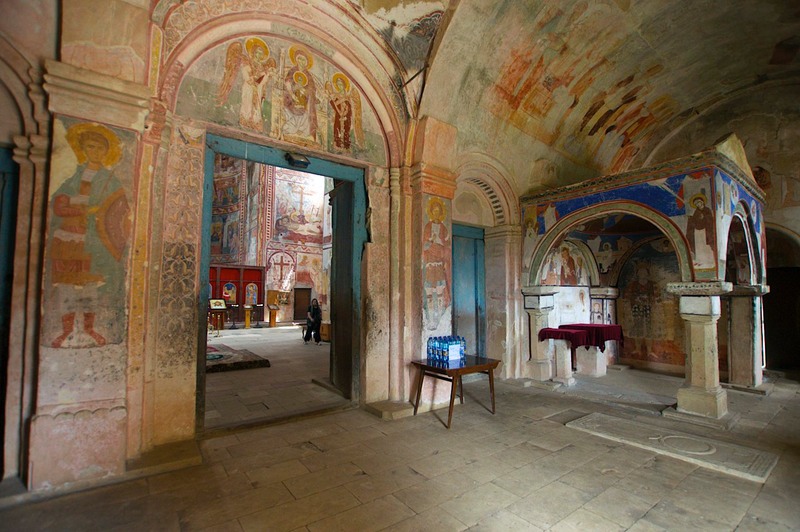
In Kutaisi, we did manage to visit the Bagrati Cathedral, high on a hill overlooking the city, and then traveled east of town to the Gelati Monastery, which was stunning, one of our best experiences in Georgia. We were never disappointed by a monastery visit in either Georgia or Armenia. The settings tend to be atop a hill, or alongside a lake, or back in the woods, or on the edge of a tiny village. Sometimes they are in ruins, sometimes completely restored and looking totally spiffed up; always delightful.
Back out into the countryside we relaxed and enjoyed our drive, dodging cows and pigs and other critters. We wondered about all these animals; was anyone caring for them? But one night we parked on the edge of a town, and we saw all the animals being gathered up at dusk and taken home; we felt better. We’ve seen animals grazing along the road in many countries of course, but Georgia was the first place where they weren’t either tied to a stake or being watched by someone. In some areas they were just everywhere, standing in the road (yes, even on major highways) as though engaged in conversation with each other and totally oblivious to the traffic. Quite amazing.
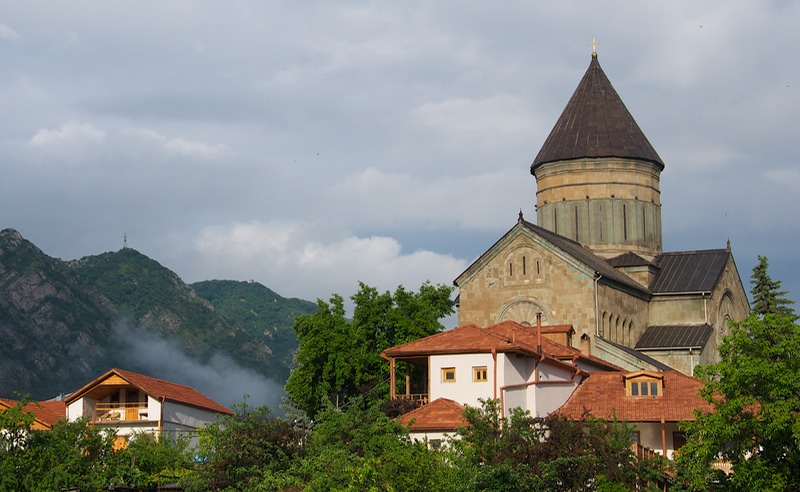
After our experience in Kutaisi, we decided we wanted no part of Tbilisi. This was a shame, as there are many interesting things there; but a heart attack is just not in our plans for this year! So we approached from the north, and stopped at the nice town of Mtskheta, where we stayed for a couple of days. It’s a charming place, with a nice cathedral and close enough to the city to have good facilities – including a great tourist office with internet. Mtskheta lies on the road, the Georgian Military Highway, that goes due north from Tbilisi to the Russian border. The original track goes back forever, but the modern road was engineered by the Russians in the 19th century when they first occupied the Caucasus. In 2010, the border crossing was opened to some international travel, although not to us; Russian and Georgian residents only can cross here.
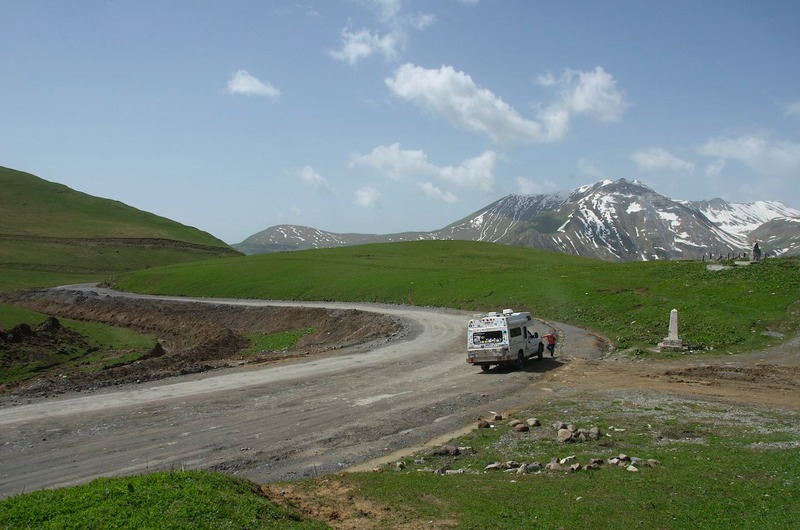
But the road is a killer ride, through spectacular and wild mountains. It is in good shape almost to the top of Jvari Pass (7800 feet) and then disintegrates to mud and potholes. As you might guess, we got all the way up the pass before turning back. A short ways beyond there lies Kasbegi, the famous Tsminda Sameba church, and the border. There were numerous little tour vans (marshrutkys) buzzing around, so lots of people were making their way to the end of the open road or going on into Russia. We spent the night at a ski station most of the way up, at about 7000 feet; thought we were pretty smart, until we endured a half-hour long, humungous hail storm. We spent the entire time thinking about our solar panels, but they emerged unscathed. The volume of hail was scary, but the size of the individual bits stayed small.
And then we experienced Georgia’s back country roads at their most difficult. We were headed into the Kakheti-Telavi area, where Georgia’s wines are produced, in the eastern part of the country. We’d spotted a short cut that looked pretty interesting. It was. Lovely countryside. God-awful road. 30 miles of agony before we got to anything better. But we’re tough; we made it.
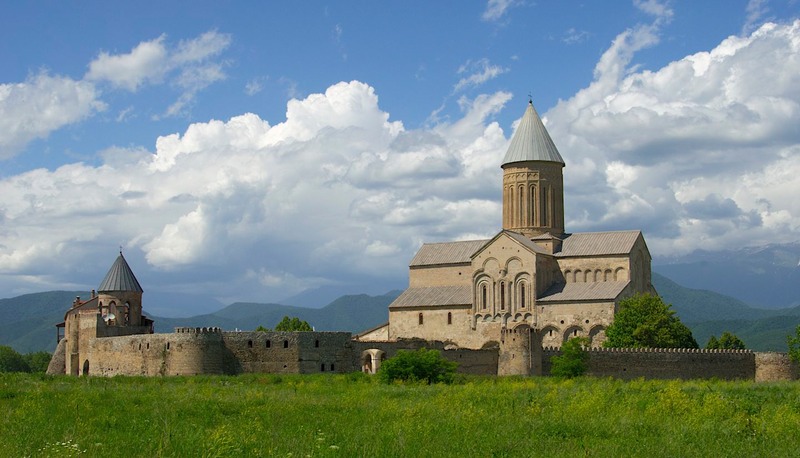
We spent a few days wandering in this pretty valley area. It is lush and green and the crops were growing beautifully. Poplar trees lining the roads, vineyards doing well, cows on the roadsides, wildflowers everywhere. Just super; it looked a lot like the Napa Valley was 50-60 years ago (well, except maybe for the cows). We puttered around the small towns, visited several old monasteries and churches, and really enjoyed ourselves. All in all, Georgia turned out to be one of the most physically beautiful countries we have visited.
And then we started further south toward Armenia. We thought about our experiences as we headed for the border. We’d seen lovely countryside, met some terrific folks, had a chance to poke around lots of old churches, and had enjoyed some great spring weather. We will see more of this country on our way back between Armenia and Turkey. For now, we were happy with our experience so far.
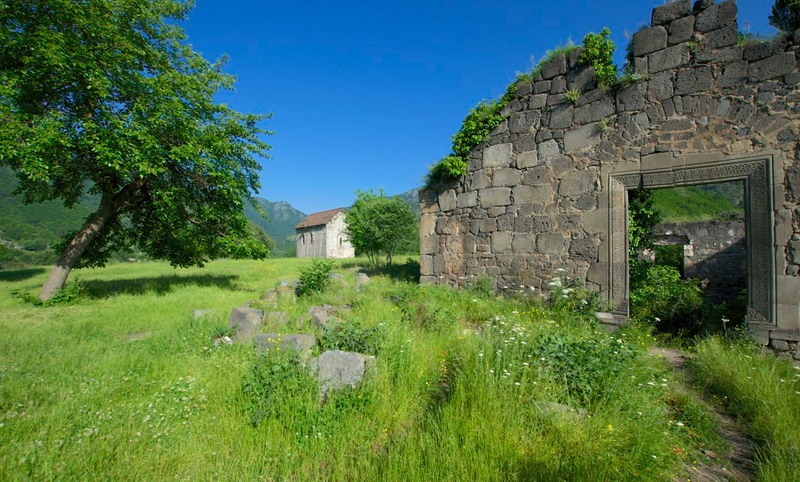
We were excited about crossing into Armenia. This is a country that I, in particular, had been hearing about for my entire life: “Eat up! Remember the starving Armenians.” There are books about genocide, the treatment of the Armenians by the Turks, and we had had intriguing experiences in eastern Turkey where we had encountered Armenian ruins and evidence of earlier inhabitants. We wanted to know more, as well as have the chance to see more lovely countryside and magnificent buildings. All of that has happened, and more.
Armenia is reportedly poorer than Georgia. Hard to say, but probably. There are fewer cities, and they aren’t as “modern” as those we saw in Georgia. There is definitely less tourist infrastructure, e.g., the tourist offices were either closed or not to be found. We’re back to old Ladas as the car most often seen on the road -- and old Russian trucks, tractors, and jeep-like vehicles were everywhere.
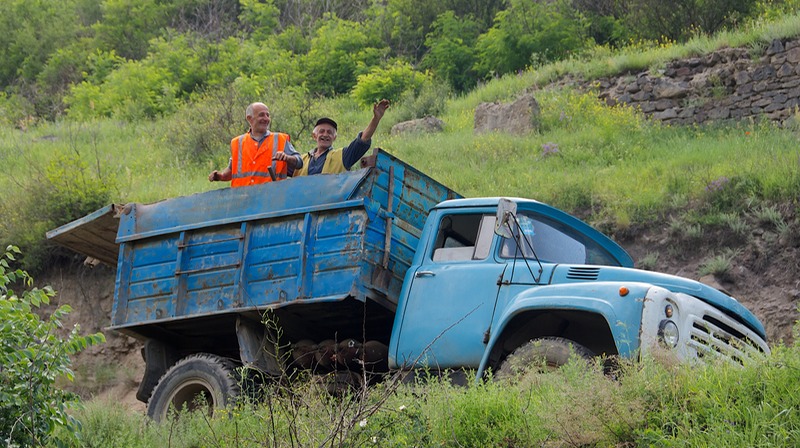
The border crossing was a bit of a hullabaloo. We had to buy visas; pay a road tax for the vehicle; and they would not accept the insurance we had purchased in Georgia, the beasts, making us pay about $45 for 15-days’ liability coverage. That last was a bummer, as we’d paid plenty in Batumi for the coverage that was supposed to be good here. Ah, well. It sure reminded us of border crossings in Central America. So did the roads. Quite possibly the worst we’ve ever seen. They are working on the problem, and you see crews out in lots of places. They cut out the area around each little pothole, then someone comes along and fills the hole. Of course, the two crews don’t work in sync. And sometimes there are so many holes there’s no place to drive. Slows you right down. This is why Rick says he thinks the drivers are better in Armenia; the roads are so bad they simply cannot drive fast. To illustrate, one day, after turning his brain to jelly on Armenian roads, Rick said: “What’s the difference between a humanitarian and a cannibal?” -- you had to have been there….
But it’s a lovely country and, despite the roads, we’ve had a good time. We don’t try to cover much ground per day; fortunately there are lots of rural fields filled with wildflowers for us to park in. And the weather has been terrific. When we’ve been at low altitude, we can tell we’re getting into summer now, but in the mountains it’s still breezy and cool. And there are plenty of mountains, most with monasteries on top. A treat each time you come around a corner.
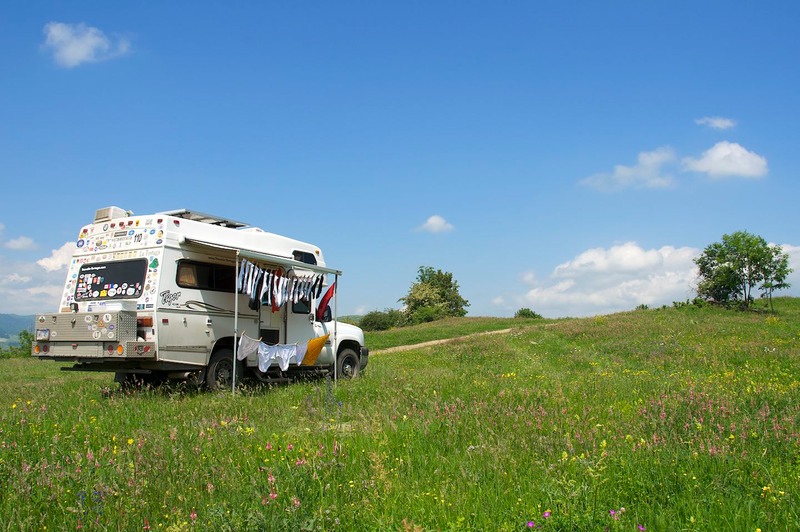
There is a lot of very productive land in Armenia, particularly along the river valleys. Field crops are showing up in all the open markets – melons and tomatoes and cucumbers and greens, etc. Fresh strawberries are still available, alongside peaches and apricots. We spent one afternoon (we were lost) wandering among the fields; the rich colors of the earth and crops are pretty, and the people were very friendly and helpful in trying to get us where we wanted to go. Interestingly, we’re still seeing cows everywhere, but fewer pigs.
We entered Armenia in the northeastern corner, made a circle through the country (it’s not very big) and came out in the northwest corner, spending almost two weeks here. We thought that was about right. We didn’t miss much that was to be seen, and took our time. We spent most nights either in monastery parking lots or out in country fields. We made all our food purchases in small local stores, finding them surprisingly well stocked. Interestingly, we never saw what you’d call a supermarket or a large fuel station anywhere in Armenia; everything was older and very small scale. The fresh produce has been excellent.
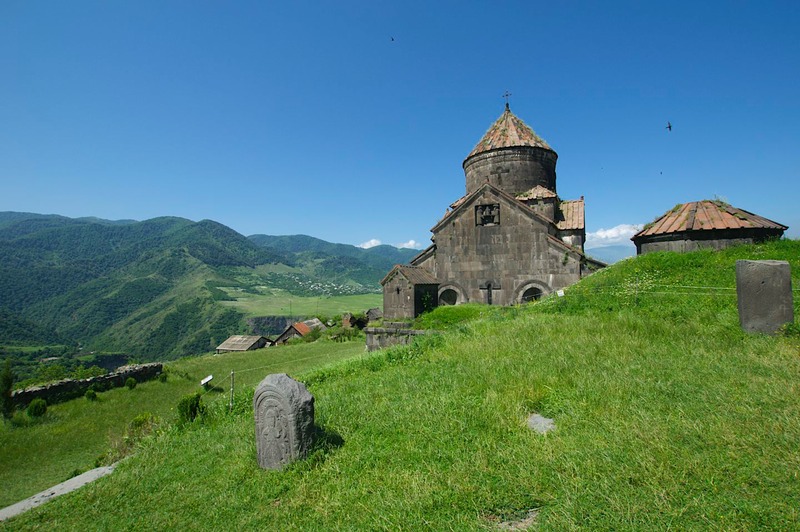
We’re calling Armenia the monastery tour. All told, we visited 10 (or was it 11?) before crossing back into Georgia. And, without exception, each one was uniquely exceptional. What an amazing heritage.
Haghpat monastery, which dates to about 976 AD, was the first we saw as we traveled down the Debed Canyon area that is the road in from Georgia, and it was quite special. We saw it early in the morning and had the place all to ourselves. One of the most charming aspects of an old monastery in Armenia is that most times the central tower is open to the sky, and is home to bats and birds, which fly around as you visit. We love it. Haghpat is a UNESCO site, and is worthy of the designation. The monks here had direct connections with the medieval development at Ani, in Turkey, which we had seen earlier this spring; we liked that. Apparently, among other things, the monastery at Haghpat was responsible for illustrating some of the famous manuscripts created at Ani. It was interesting to see, as part of the signage at Haghpat, that there is USAID money involved here. We saw this at many sites. In addition, a few days later, in Dilijan, we were talking with an Armenian woman who told us she knew several Americans who lived in town, working on various projects. We have a strong presence in Armenia at this time it would appear.
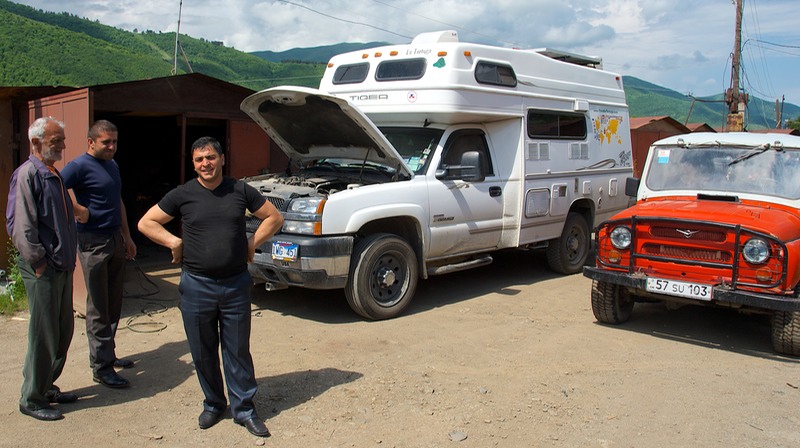
Our next adventure was with a welder in Vanajor. Yes, after a long hiatus, the World Wide Welding Tour has been resumed. This was one of those things that could have been quite serious, but as it happens was nothing more than a hiccup midway through the morning. We carry Tiger’s spare tire up front for various reasons having to do with weight distribution and storage arrangements; have done since the very first. Well, all of a sudden the goshdarn thing was lying on the street. The mount had broken and the spare fell right down. Had this happened rounding a curve on some high mountain pass it would have been a major problem, but it happened just as we were pulling to a stop in the middle of a fairly large town; the tire didn’t even drag or anything. We pulled to a stop and… plop, down it went. We felt a little something and then some guys nearby were pointing at it. It was one of those times when we thought maybe we do lead a charmed life to some extent. Anyway, one of the guys helped us pick the thing up and get it inside the Tiger, then, indicating for us to follow him, he led us a short distance to a welding shop where a repair was made and we were on our way again; all within about thirty minutes. Lucky!
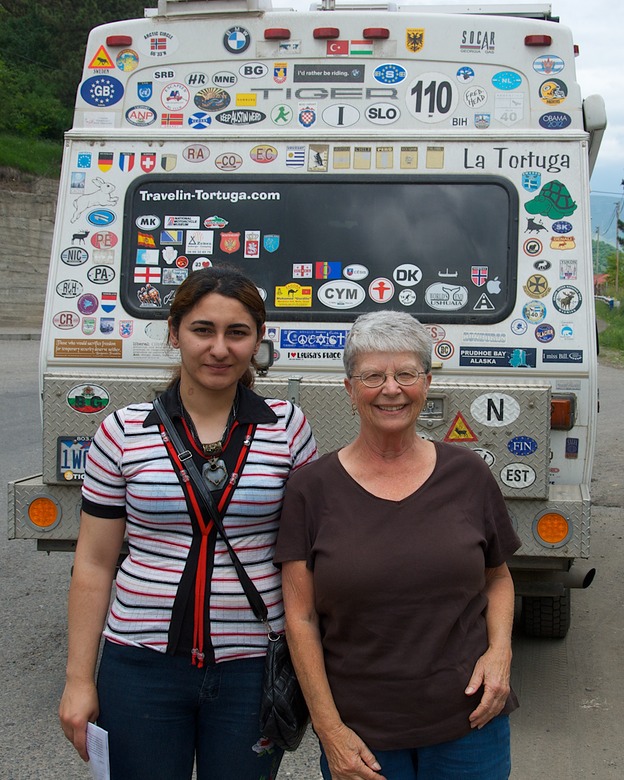
Re-welded, we were heading for Lake Sevan, but made a stop first in the resort town of Dilijan, on the way. It was a popular spot during Soviet times, and is a pretty place in the mountains. We tried hard to find someone who could help us locate internet or the tourist office – or understand us at all. Suddenly, a woman came up to me as I crossed the street, offering to help and saying she lived here. (I’m surprised she was willing to speak to me, after hearing me curse the motorist who had just tried to run me down.) Arpine Martirosyan took us home with her to use her internet. She and her sister both spoke good English, were working hard to learn more, and were happy to practice on us. They fed us coffee and goodies and turned us loose on their computer; we were delighted. It was very interesting to see their home, which they had recently moved in to. An old apartment building, many of the units had already been renovated, and they were preparing to modernize as soon as possible. We had a lovely visit, topped off by their mother and aunt stopping by to say hello. It was lots of fun. The next day, on our way out of town, we finally located a hotel we knew was in Dilijan, a Best Western of all things; they had great wifi and we were able to get some business taken care of. The staff was delighted to see us and interested in our travels. A good chat and more excellent coffee. The Armenian coffee is superb.
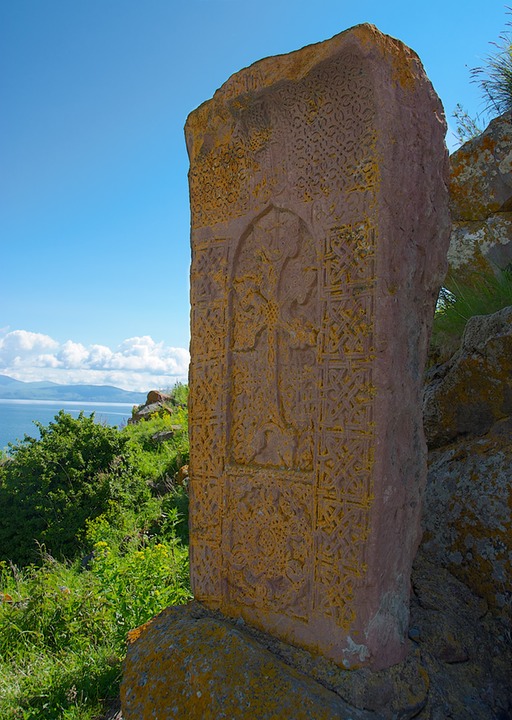
We spent a couple of days wandering along Lake Sevan, a pretty area in eastern Armenia. It’s a recreation site for fugitives from Yerevan, the capital, in the hot summer months, although still quiet now, mid-June. Right along the lake was the Hayravank Monastery, a real charmer. We stopped by early on a Sunday, and were all alone except for the ancient elderly attendant, who was happy to exchange some votive candles for a few coins. Hayravank dates back 1100 years; it’s amazing.
We could have hung around Lake Sevan for several days, but we were primed to head for the monastery at Tatev and to visit the small city of Goris, which is way far down the road into southern Armenia and getting close to the Azerbaijan border. Along the way, we drove through Martuni, with a huge regional market in progress. There were tons of animals on offer, fresh produce, rugs for sale, building supplies and firewood and bricks and concrete blocks; anything you might conceivably want. It was a hoot. South of town it was increasingly rural; there were lots of old towns, then open grassland. It looked a lot like the steppes of eastern Turkey. No surprise, as we weren’t that far away. We went over two high passes (each at almost 8000 feet), with the Yeghesis Valley in between. We were off in the middle of nowhere.
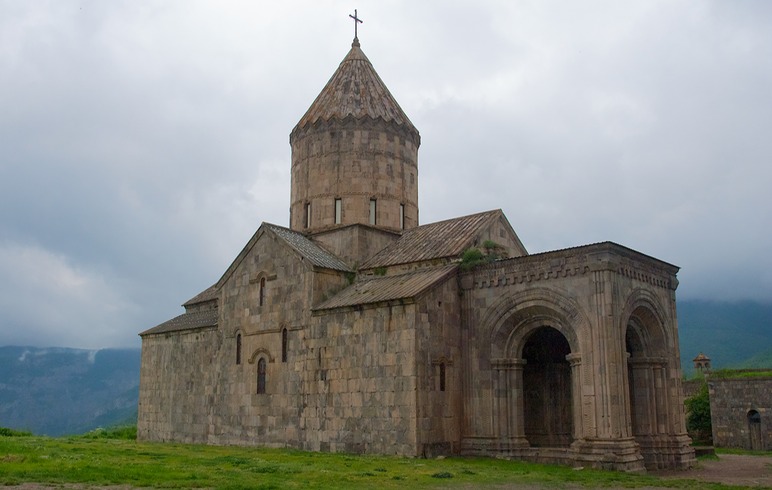
Tatev was great. It’s a very complete monastery (the earliest findings go back to the 9th century), with lots of buildings to poke around in, and – best of all – to get there we put Tiger through his paces. You go a total distance of 17.5 miles; first you drop 1740 feet in elevation in 5.6 miles, down a paved road. Then you cross the river and, now on dirt, you climb back up 1850 feet in 3.6 miles; about a 10% grade on average. Way cool. You can also take an aerial tram, which would give me the willies. Again, we had the complex to ourselves and it was lovely. Lots of bell towers with bats; inscriptions all over the place; beautiful stone work. A very worthwhile trip.
We wandered around Goris; it’s a nice town, clean and neat with nice stone buildings. It was a cold and bleak morning, but we were glad we had made it. We talked to a nice gentleman who was quite outspoken about the U.S. position on the Turkey/Armenian genocide situation. Ultimately we all agreed that governments do what they do regardless of how the people might feel on such a subject. He was quite nice about it.
Goris, at East 46º 20.719’, was as far east as we were planning to travel on the European/Asian continent. So, as they say, as we left Goris we turned our faces westward.
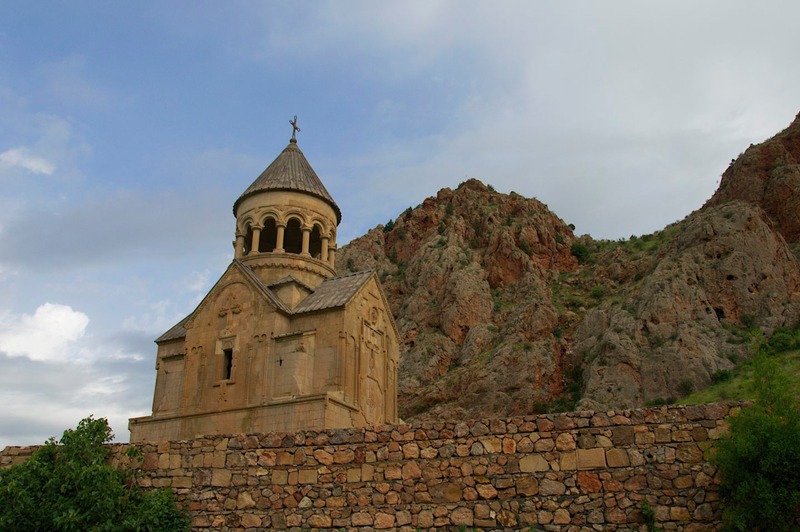
A few hours later we stopped for the night at the totally cool Noravank monastery. We’d traveled from southeastern Armenia all the way to the country’s western border. Actually, it’s not all that far – this part of Armenia sticks down into the middle of Azerbaijan; just look at your map. Noravank lies 3-4 miles up a lovely red rock canyon, and was wonderfully atmospheric. We enjoyed it a lot. It’s exquisitely redone, and is delightful. We were welcome to stay the night, and made a quiet, very special evening of it. We’ve had rain most evenings recently, starting off with huge thunderstorms in the afternoon. This time it also rained early the next morning, so we were unable to really enjoy the canyon when we left. But a few miles later, working our way toward Yerevan, our next destination, the sun came out, and so did Mt. Ararat, directly west across the border into Turkey. (You have to pay close attention here; if you thought we were across the border from Azerbaijan, that was a few miles back; there’s going to be a test, you know…). The borders in this region are quite convoluted, with Georgia, Russia, Azerbaijan, Armenia, Turkey and Iran all involved.
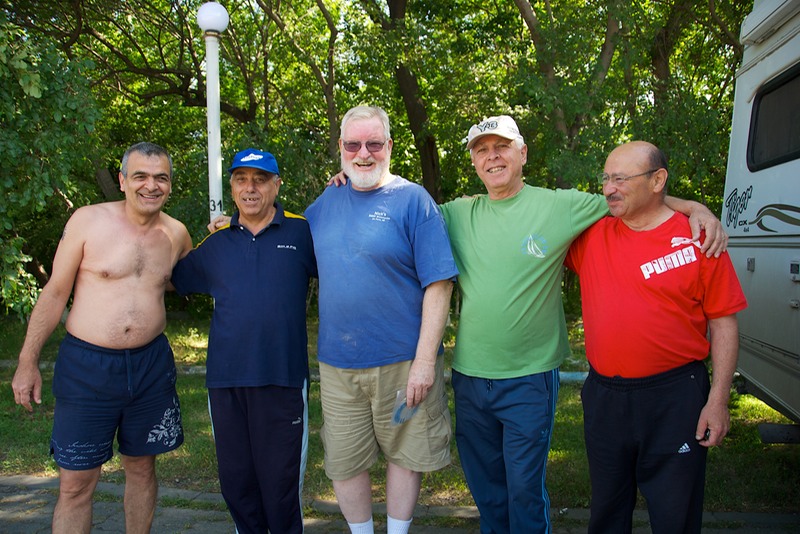
We arrived in the capital city of Yerevan and got along okay in spite of ourselves. We found the Genocide Museum and Memorial, where we settled in for the night. This is a part of town that the locals use extensively for walking and jogging and playing casual sports. We had lots of folks stopping to say hello and ask about us; many spoke a little English. It was great.
The next morning we awoke to the realization that we needed to do something about a leaking axle seal. We had time to wait before the museum would open, so we started asking the guys out doing exercises, etc. if they had someone they could recommend. We’d hate for you to get the impression that our truck gives us a lot of trouble, because it really doesn’t, but it leads a very difficult life out here on the edge and things do happen. Anyway we’ve had trouble with one or the other of the axle seals leaking before, and we carry spare gaskets just in case. Anyway, as ever, the guys spoke no English, but were happy to try to help and fortunately anyone could see what the problem was so no explanation was necessary. They chattered amongst themselves and eventually determined which of them was best suited to help us out. Edick was great.He hopped in the Tiger with us and directed us to a fellow who replaced the gasket and sent us on our way with no charge – “a gift”; since it turned out that this did not fix the problem, his generosity was especially appreciated (more later on the axle front). Afterwards, Edick took us to his own home where his wife laid out a lovely spread of coffee and numerous munchies, a neighbor lady who spoke English was invited over to translate, and another lovely adventure ensued.
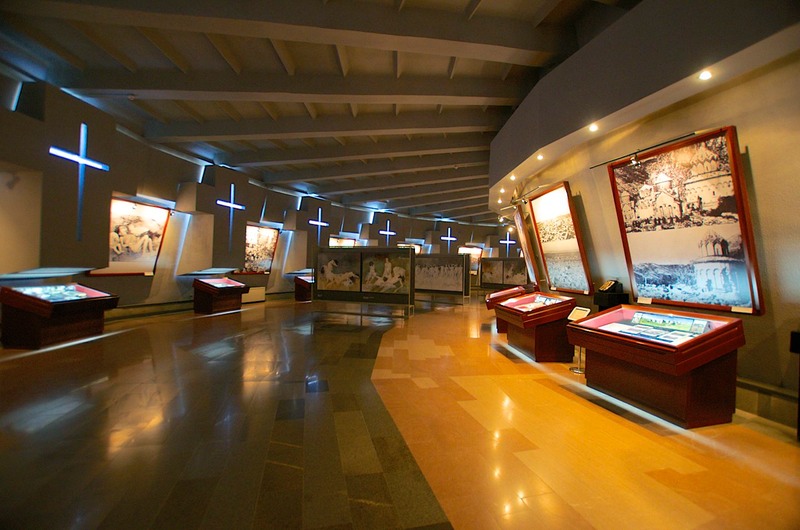
We then returned to the Genocide museum. It was a very moving experience. Outside the museum there are trees that have been planted by various countries in support of Armenia and its status as a victim of genocide. The memorial is an eternal flame surrounded by pillars representing the lost regions of Armenia. Turkey continues to deny any wrongdoing, but the evidence to the contrary is compelling; this all happened during the period between 1914-22, when about one and a half million Turkish Armenians lost their lives.
We could have stayed in Yerevan for at least another day; there is a lot to see here. But by now we were starting to think about our plans for the summer, and it was getting hotter and hotter. So we left, heading for nearby Echmiadjin, the “Vatican” of the Armenian Orthodox Church, a pilgrimage city not far from Yerevan. There are interesting ancient monasteries there, and lots to be seen. We poked around and enjoyed the wander. The local stone is a lovely warm dark brown, and the buildings are elegant to look at.
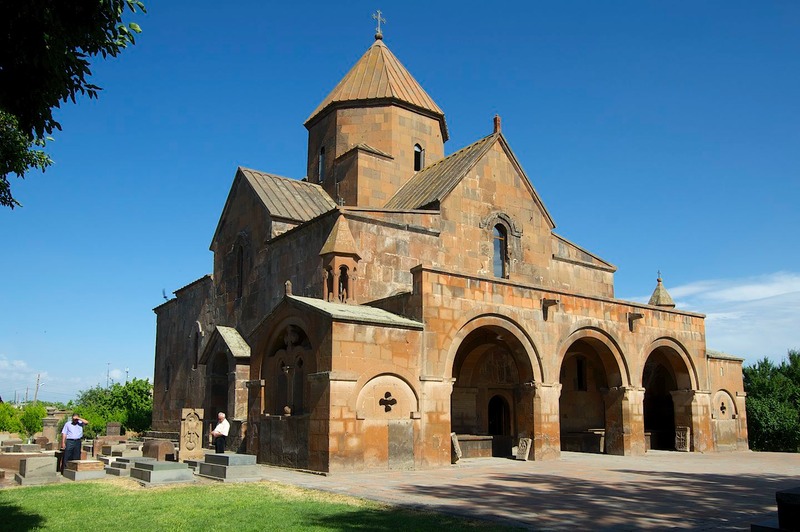
Finally heading out, we spent that night on a country road, parked beside a memorial and some apricot trees. I said hello to a lady getting out of a taxi and heading for her home; five minutes later she came back and gave me an armful of tomatoes as a gift. An older man stopped a few moments later, got out of his truck, and gave me apricots. What amazing friendly people. The memorial where we were parked is to an 1827 battle with Russia, who violated a peace treaty and started attacking in this valley, with the ultimate purpose of heading toward Yerevan and occupying it. The local forces (Armenians) held.
The next morning, sitting there in the bright sunlight, we could see the Caucasus Mountains to the north and Mt. Ararat to the south. It was a lovely area. Taking off, we moved north toward the border with Georgia. We drove along a deep gorge that has several cool monasteries in the area; we stopped to see Hovannavank right on the edge of the gorge. It was quite special, with really terrific carvings and inscriptions in the church. It’s located in a tiny village, but they’re used to folks wandering by. We were delightfully ignored; a fellow came by carrying an old shotgun. He used it to scare the birds out of the tree he subsequently climbed; he was picking cherries. Rick got water for the truck out of the fountain near the church. A young fellow was watching some sheep working their way across the monastery grounds. Children were playing nearby and old guys were sitting at a table under a tree sharing a chinwag. Such a nice spot.
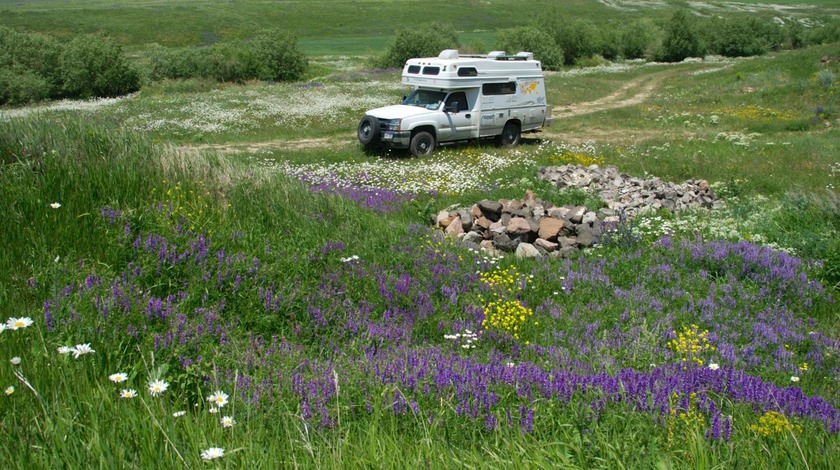
Further up into the mountains and heading towards the border, we found an isolated spot in a field that was filled with wildflowers; we stayed two days. It was lovely, cool and breezy at almost 5700 feet. While we were parked there, an elderly woman and her granddaughter passed by on the nearby track. Soon, they returned with a handful of daisies for us.
We had one last possible stumbling block before the border, getting ourselves through the city of Gyumri; amazingly, it was well signed and we were there and gone in just a few minutes. In traveling through, we noticed that there was still a lot of unaddressed earthquake damage from the quake of 1988 that had leveled large sections of the city (and many other towns in the vicinity). Armenia is quite susceptible to quakes, and far too poor to recover quickly. We left Gyumri and headed for the border, unsuccessfully searching for a recommended monastery site along the way. Once again we were defeated by lack of signage and poor maps. At the border, they were willing to let us leave, but not before collecting an additional $15.00 for some sort of vehicle exit tax.
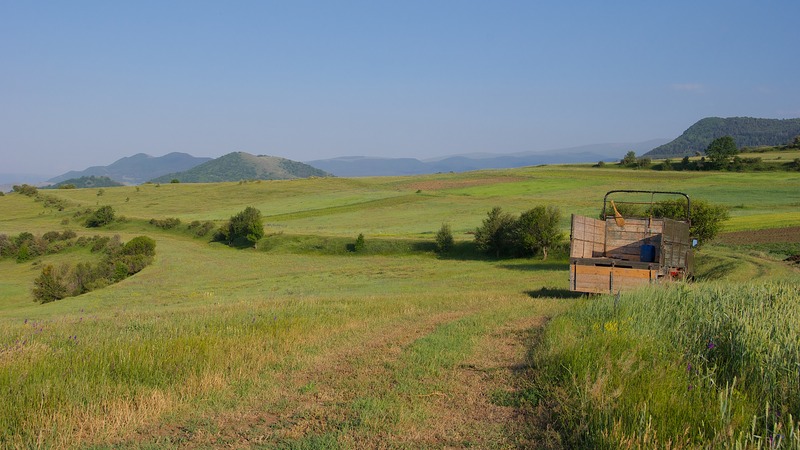
Back in Georgia, we were heading back to Batumi before crossing to Turkey. We stopped along the way at the Sapara Monastery, outside Akhaltsikhe, which was pretty special. We got part way up the hill, on a rather nasty road, then decided to pull off into another lovely field of flowers, where we stayed the night before getting up early and finishing the drive to where the old monastery clings to the side of the mountain. It was a Sunday morning, and the monks were in services, so we didn’t go inside, but contented ourselves with wandering the grounds of this tiny place that’s quite enchanting. It was a beautiful and rewarding experience.
We enjoyed a very good road for awhile and then the pavement ended and we found ourselves continuing along a very rough dirt track. We could have turned back, but darn it we really hate to do that, so we pushed on and were rewarded/punished with fifty kilometers of a rough, scrabbly little road that carried us through some really beautiful country as we moved across southern Georgia.We wouldn’t have chosen this route if our maps had not indicated that it was a perfectly usable paved road all the way, but then we would have missed seeing the area and would have been the poorer for it. At the highest point of the road, enveloped in rather heavy mist, we stopped for a chat with a French bicyclist who was doing a solo journey from his home in southern France to Bangkok, Thailand. Aren’t people amazing?
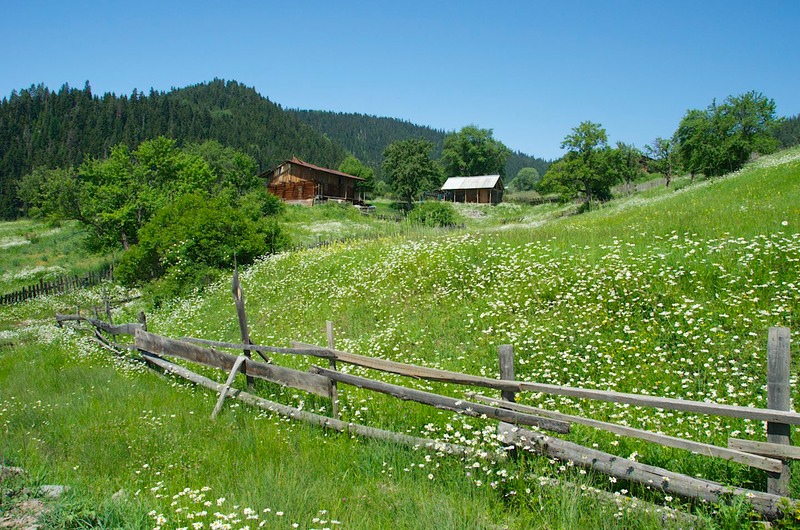
Soon we were back in Batumi. We had made this strenuous trek across southern Georgia (we could have taken an earlier turning south and crossed into Turkey many miles back) in part because we were still having a problem with the leaking axle seal. We went back to Tegeta Motors, who had done a very nice routine service for us a month earlier. They didn’t have someone available to help us, but took us to another shop that turned out to be a jewel. This was a great old shop run by two fellows, one of whom reminded us of “Rub,” a character in the Paul Newman movie, Nobody’s Fool. A little TV was on the whole time we were there, first with the soaps, and then with a movie we eventually determined was Catwoman, with Halle Berry and Sharon Stone -- dubbed in Russian. What a hoot. Anyway, long story short, these guys were pros and did a very thorough job of replacing both axle seals -- so far the repair seems to be a good one. As we often find in getting our truck worked on in less developed countries, the overall repair might not be as inexpensive as you might hope, but it’s not because of the labor costs; in this case the five quarts of differential oil was more than half the total bill.
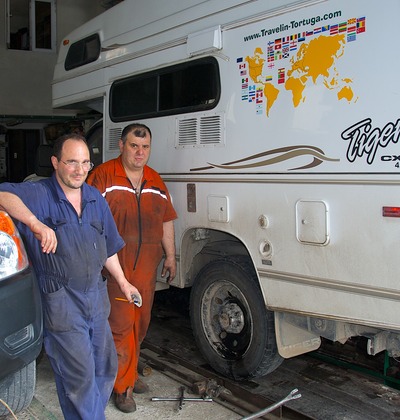
Finishing all this up, we beat feet for the border, looking forward to returning to “good ol’ Turkey” -- where we are now making our way back through Istanbul to Bulgaria. We’re planning on some downtime in Veliko Tarnovo (Bulgaria) before heading on up to Romania and more of eastern Europe. Our thanks go to the Eves, who led the way for us on this Caucasus adventure. Sadly, we were never able to meet up with them, out there on the edge, but the summer is yet young! We still hope to find them somewhere down the road.
Talk to you again soon.
Rick, Kathy and La Tortuga, with clean wheels at last